#Berenicornis comatus
Photo

White-crowned Hornbill
#white crowned hornbill#hornbill#Berenicornis comatus#Bucerotiformes#Bucerotidae#Berenicornis#bird#upl
141 notes
·
View notes
Note
if u were a human what type of bird would u be? 🤔
That would depend on the type of human
but either Calidris pugnax or Berenicornis comatus


2 notes
·
View notes
Photo

White-crowned Hornbill (Berenicornis comatus), photographed at St. Augustine Alligator Farm Zoological Park. Another spectacular Asian species! #hornbills https://www.instagram.com/p/Ced2lGLrGpY/?igshid=NGJjMDIxMWI=
0 notes
Photo
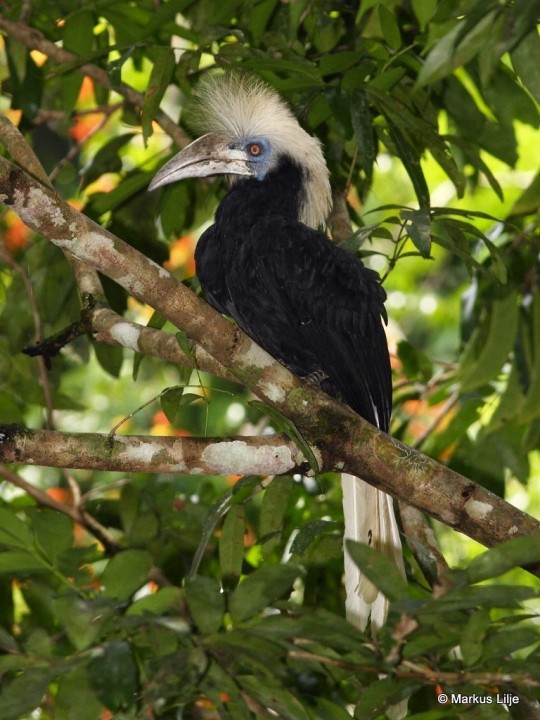
White-crowned Hornbill (Berenicornis comatus)
© Markus Lilje
198 notes
·
View notes
Photo
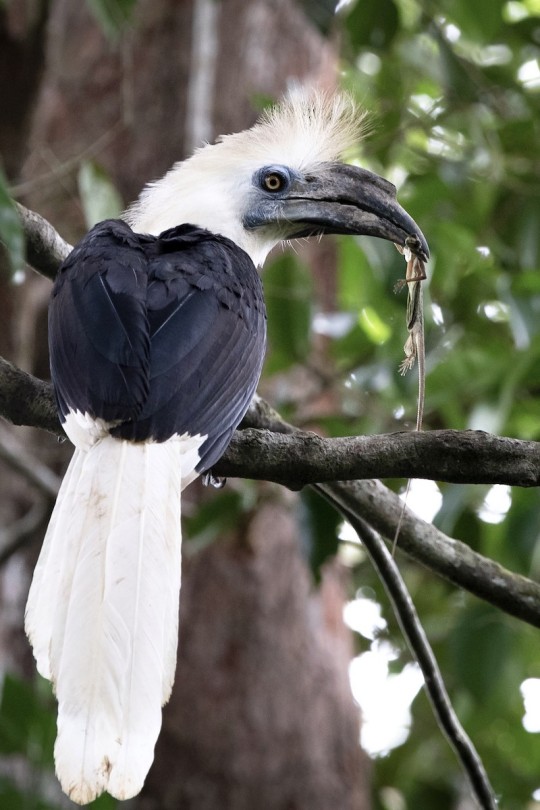
White-crowned Hornbill (Berenicornis comatus)
© Julie Edgley
40 notes
·
View notes
Text
Berenicornis comatus

By Michael Gwyther-Jones, CC BY 2.0
Etymology: Berenice’s Bird
First Described By: Bonaparte, 1850
Classification: Dinosauromorpha, Dinosauriformes, Dracohors, Dinosauria, Saurischia, Eusaurischia, Theropoda, Neotheropoda, Averostra, Tetanurae, Orionides, Avetheropoda, Coelurosauria, Tyrannoraptora, Maniraptoromorpha, Maniraptoriformes, Maniraptora, Pennaraptora, Paraves, Eumaniraptora, Averaptora, Avialae, Euavialae, Avebrevicauda, Pygostaylia, Ornithothoraces, Euornithes, Ornithuromorpha, Ornithurae, Neornithes, Neognathae, Neoaves, Inopinaves, Telluraves, Afroaves, Coraciimorphae, Cavitaves, Eucavitaves, Picocoraciae, Bucerotiformes, Bucerotidae, Bucerotidae
Status: Extant, Endangered
Time and Place: Within the last 10,000 years, in the Holocene of the Quaternary


The White-Crowned Hornbill lives on the Malay Peninsula, Sumatra, and Borneo

Physical Description: The White-Crowned Hornbill looks exactly like what you would think: it is a hornbill, with a giant tuft of white feathers on the top of its head! It ranges between 75 and 80 centimeters in body length, with a large grey bill and flat plateau on the top of the bill called the horn. The feathers on the head are primarily white in the males and black on the females, but both have white crowns on the top of the head. Bare blue patches surround their eyes. The females then continue to be black all over except for the tail, which is long and white. The males have white underbellies and grey legs, but black backs and wings like the females. Juveniles are all black and more dull than the adults.
Diet: White-Crowned Hornbills feeds primarily on other animals such as insects, snakes, lizards, and small birds, though it will also eat a variety of fruits like drupes and figs.
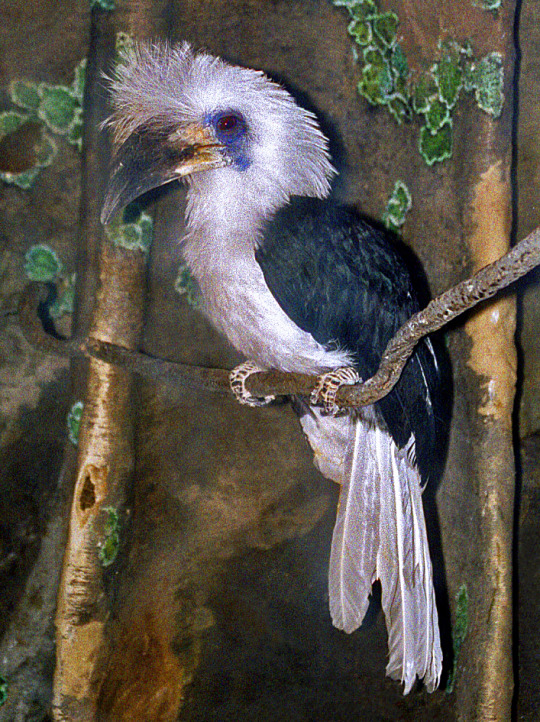
By Hectonichus, CC BY-SA 3.0
Behavior: These hornbills will forage among the tangled growth of their evergreen forest homes, usually close to the ground or in lower levels of the trees; they spend a lot of time digging in the bark and in debris for animals. They will stay in one place their whole lives and are quite territorial; they tend to make owl-like hooting calls back and forth to warn away other hornbills from their territory. They tend to lay eggs regardless of season, with nests known throughout the year; groups of three to eight birds will work together to create cooperative nests for one dominant female. Two eggs are laid, but one chick is raised by this small family. The female will seal herself in the nest hole, blocking herself with droppings and mud, and the family will bring food until the chicks are able to fly, when the female breaks the wall.
Ecosystem: White-Crowned Hornbills live primarily lowland evergreen rainforests, though it can be found in adjacent human-made plantations.
Other: These birds are endangered primarily due to very few individuals being found in certain areas - it seems to be vulnerable to habitat destruction and hasn’t been counted very well to allow for conservation efforts to be effective in the past. They are rarely observed and easily overlooked in their ranges.
~ By Meig Dickson
Sources under the Cut
"Arkive.org". Archived from the original on 2014-05-18. Retrieved 2012-10-09.
Clements, J. F. 2007. The Clements Checklist of Birds of the World, 6th Edition. Cornell University Press. Downloadable from Cornell Lab of Ornithology.
Kemp, A.C. & Boesman, P. (2019). White-crowned Hornbill (Berenicornis comatus). In: del Hoyo, J., Elliott, A., Sargatal, J., Christie, D.A. & de Juana, E. (eds.). Handbook of the Birds of the World Alive. Lynx Edicions, Barcelona.
#Berenicornis comatus#White-Crowned Hornbill#Hornbill#berenicornis#Dinosaur#Bird#Birds#Dinosaurs#Afroavian#Quaternary#Australia & Oceania#Eurasia#Omnivore#Flying Friday#Birblr#Factfile#biology#a dinosaur a day#a-dinosaur-a-day#dinosaur of the day#dinosaur-of-the-day#science#nature
214 notes
·
View notes
Note
what are your favorite birds? 😌

ANON AND @viir-tanadhal ARE THE REAL MVPS THANK YOU ILU
Okay so I’ll start with the harpy eagle (Harpia harpyja) because it’s the latest one I’ve been thinking about a lot. And also because it’s the coolest looking bird ever. Fun fact 1: they have the largest talons of any living eagle and can lift prey up to equal their own body weight (which by the way is 6-9 kg in females and 4-6 kg in males).
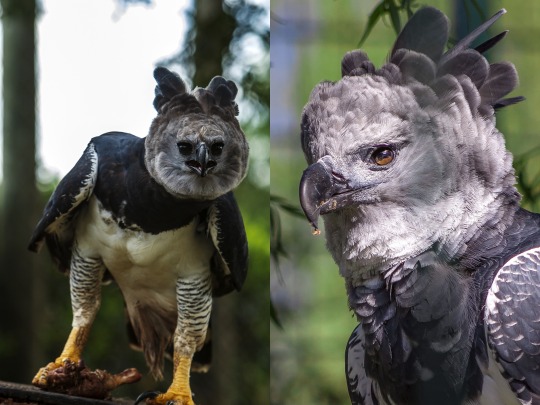
Fun fact 2: they manage to look cute, goofy, majestic, and terrifying at the same time and that’s the energy I can only aspire to.
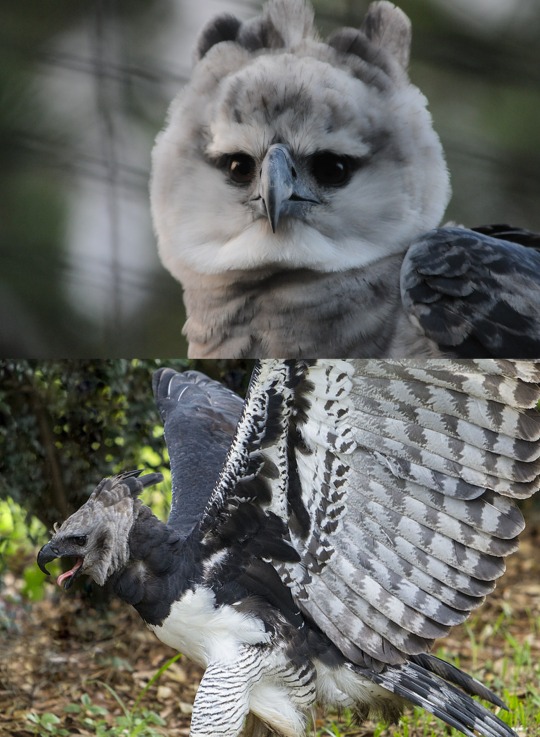
THEN I love the entire hornbill family because they’re just such good birds?? funky little dinosaurs?? Some honorable mentions include:
The helmeted hornbill (Rhinoplax vigil), which is unfortunatally critically endangered :( Fun fact: its call is a series of loud, intermittent barbet-like hoots, sometimes double-toned and over two dozen in number, which gradually accelerates to culminate in a cackle reminiscent of laughter.
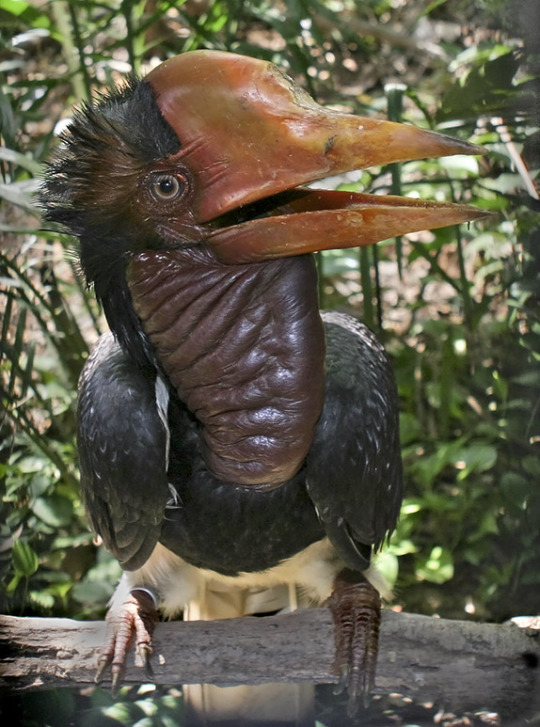
A WHOLE ASS DINOSAUR. I LOVE THEM.
The white-crowned hornbill (Berenicornis comatus), also endangered due to habitat destruction. Fun fact (and this is common among hornbills in general): the female lays two white eggs in a tree hole, then seals herself in by blocking the entrance to the nest with droppings, debris and mud. The male, and other adults and young forming a cooperative group, feed the breeding female and the chicks through a narrow hole. The female breaks the "wall" and leaves the nest when the chicks are able to fly. They’re also very fancy.

The trumpeter hornbill (Bycanistes bucinator), for whom I would die. Fun fact: when they are kept and fed in captivity, they are tame, loving birds that can be taught a variety of tricks and enjoy companionship with their owner. They are very intelligent and have a life expectancy of up to 20 years.
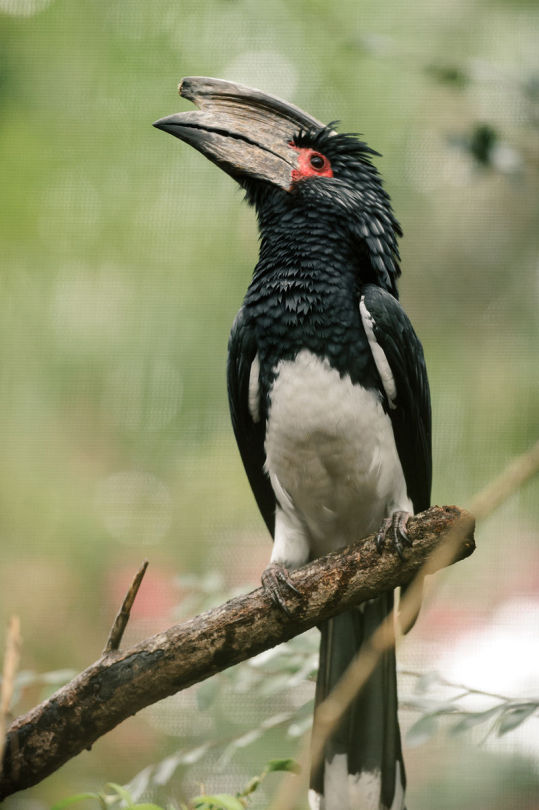
Also would die for the black-and-white-casqued hornbill (Bycanistes subcylindricus):
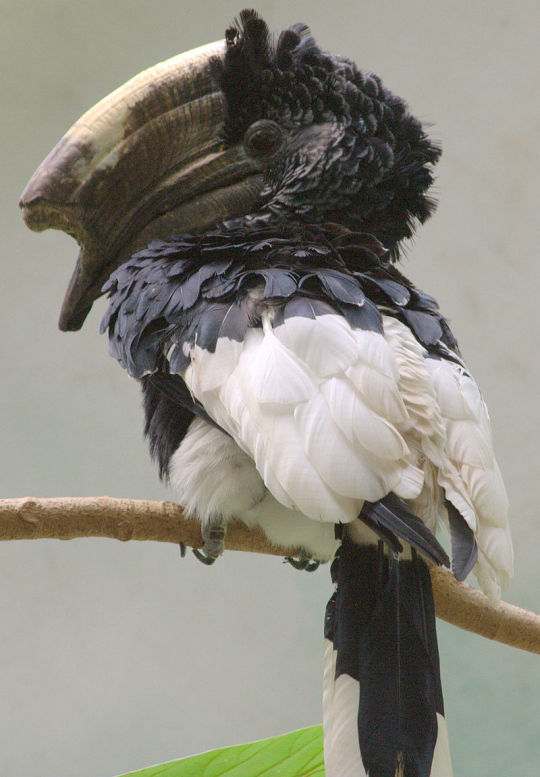
The rhinoceros hornbill (Buceros rhinoceros), AN ALL TIME FAVE. Imagine Jurassic Park but it’s just these dude:
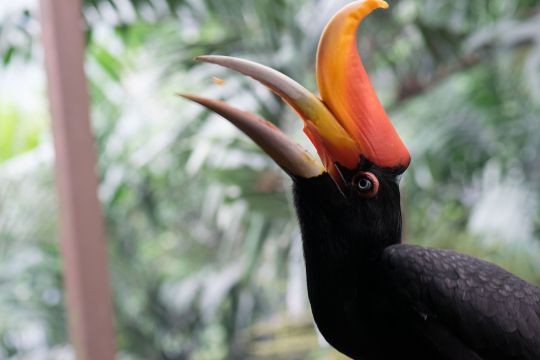
Also look at this pair pressing forehead together. You might call this,,,,,,,,, the beak of romance.

I’LL STOP HERE BECAUSE THIS LIST IS LONG ALREADY. But basically birds are cool as fuck but none of them are as cool as the hornbills.
Oh no, actually one more!!!! The McFreakin shoebill (Balaeniceps rex). The latin name basically translates to “whale-head king” or something like that. Absolute legend. They’re sometimes refered to as B. Rex, which! fun fact! B-rex is also a speciment of Tyrannosaurus. Idk what significance this has but it’s A Fact that now you know too.

OKAY THAT’S ALL FOR NOW. THANK YOU ASKING. I LOVE BIRDS. HAVE A NICE DAY.
#asks#anonymous#replies#viirtanadhal#birds#about me#long post#ALSO THE LYREBIRDS??#and the whooping crane#flamingos#barn owls!!#every corvid ever#GOD THERE ARE SO MANY I LOVE#birds are just............ they're superb#excelent creachers#thank you again for letting me ramble about this ♥♥♥
14 notes
·
View notes
Photo
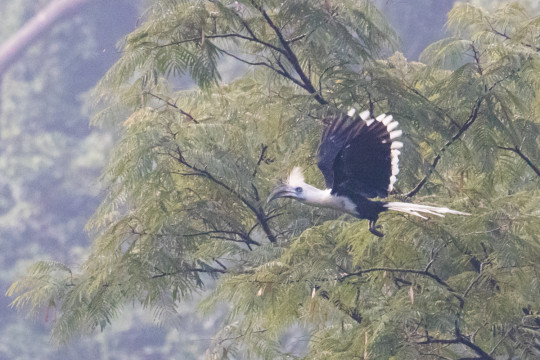
Illustration Photo: Bukit Lawang, Sumatra, White-crowned Hornbill - Berenicornis comatus (credits: Peter Steward / Flickr Creative Commons Attribution-NonCommercial 2.0 Generic (CC BY-NC 2.0))
Whitley Awards for Grassroots Conservation leaders in developing countries
For Afghanistan, Armenia, Algeria, Angola, Bolivia, Colombia, Bangladesh, Egypt, Jordan, Benin, Cape Verde, Lebanon, Bhutan, Côte d'Ivoire, Peru, Burkina Faso, South Africa, Cambodia, Ghana, Tunisia, Chad, Guatemala, Congo DRC, India, Djibouti, Indonesia, Ethiopia, Gambia, Morocco, Guinea, Haiti, Mongolia, Kenya, Nicaragua, Laos, Nigeria, Liberia, Pakistan, Madagascar, Palestinian Territories, Malawi, Philippines, Mali, Sri Lanka, Mozambique, Vietnam, Myanmar, Nepal, Niger, Rwanda, Sao Tomé and Principe, Senegal, Sierra Leone, Somalia, Tanzania, Togo, Uganda, Zambia
We support grassroots wildlife conservationists through our flagship prizes, the Whitley Awards. These coveted Awards are presented by our Patron, HRH The Princess Royal at an annual ceremony held in London each spring. They are won competitively following assessment by an expert academic panel and are worth £40,000 in project funding over one year.
Winning a Whitley Award is not just about receiving financial support; it comes with a significant boost in profile and provides an international stage for winners to draw attention to the environmental issues they face. Winning a Whitley Award can increase visibility, generate local and national pride and catalyse political action to support conservation leaders and their NGOs. During the Awards week, winners receive professional media and speech training to enable them to effectively communicate their important work and inspire further philanthropic support. Tailor-made films narrated by WFN Trustee, Sir David Attenborough, PR assistance and publicity materials are distributed to the UK and overseas media to raise awareness and champion their success.
What kind of conservation work does WFN fund?
Ecosystem landscape level approach – WFN has a broad scope of interest but projects must be focused on nature conservation. Threatened habitat conservation; projects utilising flagship species as a focal point for mobilising local communities; biodiversity conservation and linked livelihood development projects which reduce pressure on wild resources or utilise wild resources sustainably; human-wildlife conflict resolution; anti-poaching; in-situ conservation of endangered species – all would be projects we are interested in. In all cases, measurable biodiversity conservation impact is essential. Projects that take an ecosystem approach are generally favoured over a purely species specific approach. Take a look at our past winners in the Winners’ Projects section of our website to get a better idea of what WFN fund.
Local stakeholder involvement – WFN look for projects which actively involve and genuinely engage the local community and build capacity. Community and stakeholder education is considered very important to successful nature conservation projects. But winning projects will have an explicit biodiversity conservation focus. Purely or predominantly rural/development projects will not be eligible.
Evidence of prior success of proposed activities is essential, with appropriate metrics.
Pragmatic, replicable and scalable – Pragmatic, grassroots initiatives will be given priority over purely scientific or academic activities. WFN is keen to support those who have started on a smaller scale and now want to expand, replicate or scale up their activities. WFN value the experience and strong local knowledge project leaders acquire on a small scale, and their enthusiasm to apply this on a larger scale. We do not fund pilot or start up projects.
Measureable outcomes – We seek projects that deliver real change and include actions that will have clear, measurable outcomes. It is important to demonstrate that careful thought has been given to determine what indicators can be measured to evidence impact. For example, where training is undertaken – how will you measure actual change in behaviour, what will be the actual change delivered as a result of workshops; how will you know if the anti-poaching patrols have been effective or if the protected area is having the desired results?
WFN cannot provide funding for MSc/ PhD work, expedition or conference attendance, land purchase or building construction and animal welfare projects. Captive breeding projects are only considered if the underlying cause of species decline in the wild has been addressed.
Eligibility
Whitley Awards are for dynamic, mid-career conservationists who are leading wildlife conservation projects in the Global South. Winners tend to be nationals of the country in which they are working who are seeking to scale up proven work that would benefit from further funding, a profile boost and international support. To be eligible, projects must involve communities at the grassroots level and deliver practical action that is founded on science.
Not High Income Economy countries – Wildlife conservation projects led by local leaders based in countries that are not defined as a High Income Economy by the World Bank. Exceptions to this criterion include Equatorial Guinea and certain island nations in the Caribbean. If you have any questions about eligible countries, please contact WFN.
Nationals with local support – a key focus of the Whitley Award is to boost the profile of leaders who are nationals of the country in which they are working. There are some exceptions, for example long term residency (15+ years) or commitment to country/region/ building capacity of local team members for future leadership.
We seek grassroots conservationists from locally incorporated NGOs in developing countries, rather than in-country staff employed by NGOs headquartered in developed countries – but if you are in doubt please contact us.
Good communicators and passionate people – people who will inspire others and importantly, who will collaborate and share results. Please note applicants must be able to communicate in English.
Leadership and teamwork – Whitley Awards are won by individuals backed by an appropriate team/organisation. Individuals working in isolation and team/joint entries are not eligible.
Projects that are based on scientific evidence and understanding – this can be in the leader, expertise on the team, or via partners/collaboration.
Work involving (and benefitting) the local community and stakeholders is essential.
Ecosystem / landscape level projects are preferred. Genuine flagships are accepted, but not if results are purely species-specific.
Projects must be able to demonstrate past success and an evidence-based approach. We do not fund pilot projects or work that is at the start-up stage.
Grassroots, pragmatic work that is realistic, but ambitious too. We look for applicants on the cusp of ‘something big’ and work that is replicable or scalable.
Actions that will have clear, measurable outcomes – we look for applications that have given careful thought to what indicators can be measured to evidence impact.
Sustainable projects – we want the work to continue into the future, well past the Whitley Award. Successful proposals will demonstrate long-term planning.
Projects that demonstrate value for money and ability to manage funding at the Whitley Award level (£40,000). Organisations with Audited Accounts are preferred.
Projects for which an Award will make a big difference. Priority will be given to those that can demonstrate need.
Work that needs publicity – ones that will do well if ‘doors can be opened’ via the media and enhanced recognition.
Application Deadline: midnight GMT on 31st October 2021
Check more https://adalidda.com/posts/QDjmQWmnNve8hn7Z4/whitley-awards-for-grassroots-conservation-leaders-in
0 notes
Text
นกเงือกหัวหงอก
ชื่อวิทยาศาสตร์ / Scientific name : Berenicornis comatus
ลำดับ / Order : Bucerotiformes
วงศ์ / Family : นกเงือก Hornbills : Bucerotidae
ในบรรดานกเงือกที่ผสมพันธุ์ในปักษ์ใต้ มี 3 ชนิดที่พบเห็นยากมาก ๆ ได้แก่ นกเงือกดำ นกเงือกหัวหงอก และนกเงือกปากย่น ชนิดหลังพบเห็นที่ป่าฮาลาบาลาเท่านั้น ส่วนนกเงือกหัวหงอกและนกเงือกดำ พบเห็นได้ในพื้นที่ปักษ์ใต้กว้างขวางกว่า กระนั้นก็ใช่ว่าจะได้เห็นง่ายๆ คนเขียนเคยไปดูนกที่ป่าบาลา จ.นราธิวาส ก็พบนกเงือกที่กล่าวมาทุกชนิด ยกเว้นนกเงือกดำและนกเงือกหัวหงอก
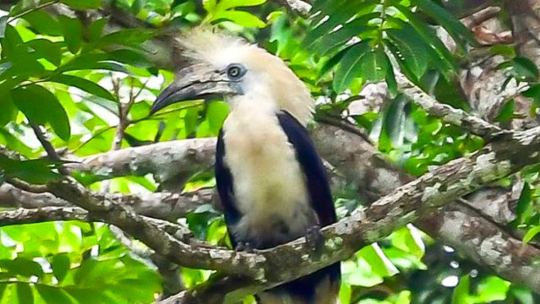
ลักษณะและอุปนิสัย
นกเงือกหัวหงอก ตัวเต็มวัยมีขนที่มีหัวสีขาวฟูคล้ายหงอน เวลาบินจะเห็นหางสีขาวชัดเจน ขนหางมีความสั้นยาวไล่จากด้านนอกเข้าหาเส้นกลางซึ่งยาวที่สุด ขนปีdสีดำมีปลายปีสีขาว ปากและโหนกขนาดเล็กมีสีดำ ตัวผู้มีคอและท้องสีขาว ตัวเมียมีขนส่วนนี้สีดำ ตัววัยรุ่นมีขนตามตัวขาวประดำ โคนหางดำปลายหางขาว ขนปลายปีกขาว นกเงือกหัวหงอกจะอยู่รวมกันเป็นฝูงเล็ก 4-7 ตัว บางครั้งมากถึง 20 ตัวเป็นนกขนาดใหญ่ (90 ซม.) ตัวเต็มวัยหัวมีหงอนขนสีขาว ปากสีดำ โหนกแข็งมีขนาดเล็ก ลำตัวสีดำ หางยาวสีขาว ขณะกางปีกหรือบินจะเห็นขอบปลายปีกมีแถบสีขาว ตัวผู้บริเวณใบหน้า คอ และลำตัวด้านล่างมีสีขาว ตัวเมียบริเวณคอและลำตัวด้านล่างมีสีดำ ตัวไม่เต็มวัยลักษณะคล้ายตัวเมียแต่ลำตัวด้านล่างมีสีน้ำตาล หางสีดำ ปลายปีกมีแถบกว้างสีขาว ปลายขนคลุมขนปีกสีขาว เสียงร้อง อุ๊…อุ๋ ชอบอยู่ในป่าต่ำจนถึงป่าดงดิบ ส่วนใหญ่จะพบที่ระดับความสูง 120-820 เมตรจากระดับน้ำทะเล หากินบริเวณใต้เรือนยอดของต้นไม้ หรือที่ระดับผิวดินเล็กน้อย เป็นนกที่บินเงียบมาก

อาหาร
นกเงือกหัวหงอก ชอบกินทั้งผลไม้เช่น ไทร ตาเสือ ฯลฯ และสัตว์ เช่น กิ้งก่า แมลงต่าง ๆ ชอบกินอารหารจำพวกสัตว์มากเมื่อเทียบกับนกเงือกชนิดอื่น

การทำรังและเลี้ยงลูก
นกเงือกหัวหงอก จะเริ่มปิดโพรงราวเดือนพฤษภาคม ลูกนกออกราวเดือนกันยายน ทำรังในต้นตะเคียน หว้าหิน พฤติกรราการเลี้ยงลูกเป็นแบบ มีผู้ช่วยหรือญาติมาช่วยเลี้ยง ผู้ช่วยมีทั้งตัวผู้และตัวเมีย

ถิ่นอาศัย, อาหาร
พบในทวีปเอเชียแถบสุมาตรา บอร์เนียว มาเลเซีย เวียดนาม เทือกเขาตะนาวศรี สำหรับในประเทศไทยพบเฉพาะทางภาคใต้ และบางแห่งของภาคตะวันตก เช่นอุทยานแห่งชาติแก่งกระจาน

พฤติกรรม, การสืบพันธุ์
ชอบอยู่รวมกันเป็นฝูงเล็ก ๆ ชอบส่งเสียงร้องดังอยู่เสมอ อาศัยตามป่าดงดิบชื้น ตั้งแต่ระดับเชิงเขาจนกระทั่งความสูง 600 เมตรจากระดับน้ำทะเลหรือสูงกว่า
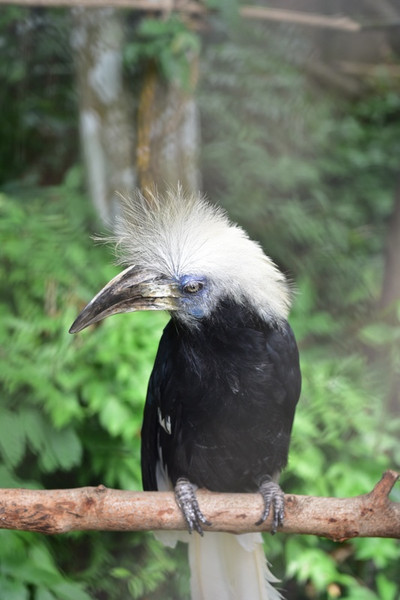
พฤติกรรมการผสมพันธุ์ของนกเงือกหัวหงอก เป็นลักษณะเดียวกับนกเงือกชนิดอื่น โดยตลอดชีวิตจะไม่มีการเปลี่ยนคู่เลย ���ัวเมีย��ะวางไข่ในโพรงไม้ ตัวผู้เป็นฝ่ายหาอาหารมาป้อนแม่นกและลูกนก
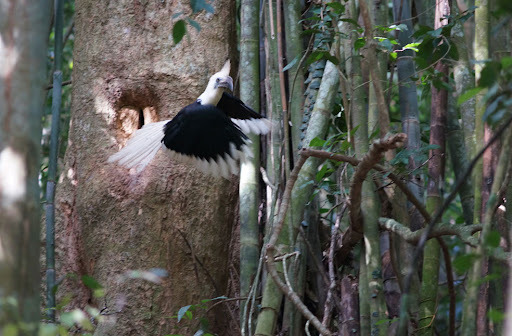
สถานภาพปัจจุบัน
ปัจจุบันมีแนวโน้มใกล้สูญพันธุ์ จัดเป็นสัตว์ป่าคุ้มครอง ตามพระราชบัญญัติสงวนและคุ้มครองสัตว์ป่า พุทธศักราช 2535
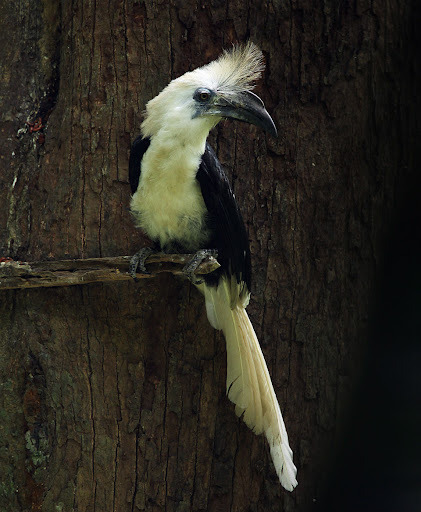
ขอขอบคุณผู้สนับสนุนหลักอย่างเป็นทางการเว็บ Fast98 เป็น ฟรีเครดิต ไม่ผ่านเอเย่นต์ ฝาก-ถอนระบบออโต้ มีแอดมินบริการตลอด 24 ชั่วโมง
0 notes
Photo
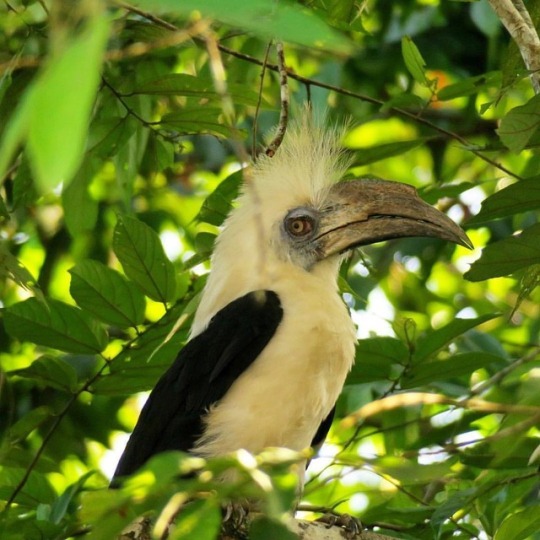
Here’s a species of hornbill I haven’t featured before. I believe it’s the White-Crowned Hornbill (Berenicornis comatus). It’s very distinctive with its spikes “hairdo” or should I say “featherdo?“ ・・・ This is a #repost from @ronald.lo via @PhotoAroundApp White Crowned Hornbill. #ercsabah #thephotonoob #borneobirds #WhiteCrownedHornbill #Hornbill #Borneo #BirdsOfBorneo
2 notes
·
View notes
Photo

Saw a white-crowned hornbill (Berenicornis comatus) stopping by our field centre😍
Source: https://bit.ly/39vTj0z
0 notes
Text
Helmeted hornbill, on verge of extinction, finds respite in new zone outside of known range
http://bit.ly/2h0fq6H
A conservation area in western Borneo holds an unexpectedly rich population of the helmeted hornbill, a bird driven close to extinction by poaching for its distinctive casqued beak, a field survey has found. A research team from the conservation group Planet Indonesia recorded over 50 visual and audio detections of the hornbill during its yearlong survey in the protected area in northwestern Kalimantan, the Indonesian part of Borneo. The discovery indicated a large concentration of the helmeted hornbill (Rhinoplax vigil), said Adam Miller, executive director of the NGO, in a statement. A helmeted hornbill is sighted by the Planet Indonesia research team at a protected site in western Borneo. Photo courtesy of Planet Indonesia. While Borneo in general is known to be a habitat of the species, Miller pointed out that his team’s findings were the first to detect the bird’s presence in the protected region. “When we found the helmeted hornbill … we could not believe it,” Miller wrote in a separate email. “We had not expected this rainforest to be so rich with hornbills.” Stretching across 1,800 square kilometers (695 square miles) of forested area, the remote landscape covers three administrative districts and connects to a national park in Malaysia’s Sarawak state. Other than the helmeted hornbill, Miller said, the region contains seven other hornbill species: the oriental pied hornbill (Anthracoceros albirostris), the bushy-crested hornbill (Anorrhinus galeritus), the wreathed hornbill (Rhyticeros undulatus), the black hornbill (Anthracoceros malayanus), the white-crowned hornbill (Berenicornis comatus), the rhinoceros hornbill (Buceros rhinoceros) and the…
0 notes
Photo

White-crowned Hornbill - Berenicornis comatus
This striking birds is a White-crowned Hornbill, Berenicornis comatus (Bucerotiformes - Bucerotidae), a Near Threatened species confined to southern Myanmar, southern Thailand, Peninsular Malaysia, Sumatra and Borneo. A population has also recently been discovered in Cambodia.
The most noticeable feature of this fantastically bizarre looking bird is its white crown feathers which erect in a spiky crest. The white-crowned hornbill also possesses an ornamental casque on top if its bill, characteristic of many hornbills.
The White-crowned Hornbill is generally uncommon, but possibly overlooked owing to its unobtrusive habits (that remains beneath the forest canopy, and so is most often heard), only sighted when flying across gaps in the forest in small groups.
References: [1] - [2] - [3]
Photo credit: ©Massimo Greco | Locality: captive, Phuket Zoo, Thailand (2006)
#nature#animals#white-crowned hornbill#berenicornis comatus#berenicornis#thailand#fauna#wildlife#near threatened#birds#hornbill#aves#bucerotiformes#bucerotidae#zoology#ornithology#white#blue#original
499 notes
·
View notes
Photo
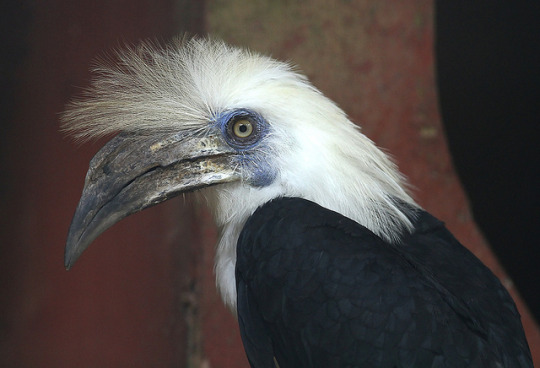
White-crowned Hornbill by kampang on Flickr.
31 notes
·
View notes
Video
A Pair of White-Crowned Hornbills (Berenicornis comatus) In Borneo. • • • #BorneoWildlife #Hornbills #WhiteCrownedHornbills #Borneo #Kalimantan #Sarawak #Sabah #Rangkong #BerenicornisComatus https://www.instagram.com/p/B8VecjbA5Jw/?igshid=1456xt07cm5y9
#borneowildlife#hornbills#whitecrownedhornbills#borneo#kalimantan#sarawak#sabah#rangkong#berenicorniscomatus
0 notes
Video
A Pair of White-Crowned Hornbills (Berenicornis comatus) In Borneo. • • • #BorneoWildlife #Hornbills #WhiteCrownedHornbills #Borneo #Kalimantan #Sarawak #Sabah #Rangkong #BerenicornisComatus https://www.instagram.com/p/BtpbIHNgkoi/?utm_source=ig_tumblr_share&igshid=qjthpnncy2wo
#borneowildlife#hornbills#whitecrownedhornbills#borneo#kalimantan#sarawak#sabah#rangkong#berenicorniscomatus
0 notes